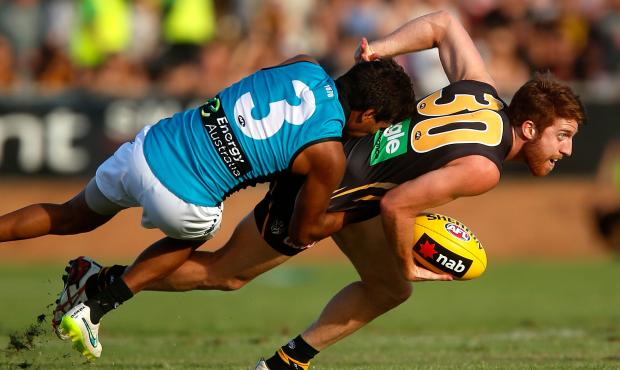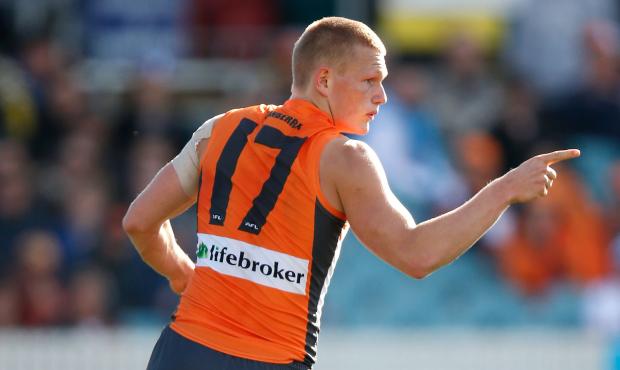SIX YEARS into the tenures of respective coaches Damien Hardwick and Brad Scott, why are Richmond and North Melbourne contemplating another year of being 'almost-but-not-quite'?
As they prepare to clash in Hobart on Saturday, both clubs will already be considering whether they have flag-winning lists after underwhelming starts to 2015.
Match preview: North Melbourne v Richmond
Conventional wisdom says the introduction of Gold Coast and Greater Western Sydney has slowed their list builds, with the draft concessions given to the expansion sides denying the Roos and Tigers access to top-end draft talent.
While opinion within industry figures was far from uniform, everyone agreed that choosing the right players was only part of the equation.
One recruiter told AFL.com.au he thought the expansion effect might be overstated. His view was that the development of players, regardless of where they were taken in the draft, was what really mattered.
Another stated categorically that the expansion years have slowed their rebuilds.
He said evidence for that argument could be found by examining the state of each list when expansion hit, by looking at each club's development and wellbeing programs, and their culture when 2010 – the first year of the compromised drafts – rolled around.
Following that, Geelong, Collingwood, the Sydney Swans and Hawthorn partly owe their extended periods of recent success to the effect of expansion.
Those clubs had established lists, settled TPP strategies and a jump on the competition in the area of development.
At the same time, Richmond and North Melbourne – and clubs like Adelaide, Carlton, Essendon, West Coast and the Western Bulldogs – have largely meandered in the middle-rungs of the ladder.
In other words, the Tigers and Roos have been competitive without ever being serious premiership contenders.
A good starting point to understanding why this is the case is the beginning of the recent expansion period. More precisely, the drafts of 2010-11, when the Suns and Giants were handed unprecedented access to first-round draft selections.
Even though good players can be found at any pick – and early draft picks don't always work out – players taken in the first 10 picks can often make clubs threatening.
Top-10 picks won six of the past 10 Norm Smith medals. Twelve of the AFL's 20 captains and co-captains were selected in the top 10, while Nathan Jones, Shannon Hurn and Robert Murphy were selected within the top 13 picks.
Richmond had one top-10 selection in the two compromised years – No.6 (a pick with a horror draft history), used on Reece Conca.
As it stood, the Tigers could have had Josh Caddy, Dyson Heppell, Dion Prestia or Tom Lynch at that selection.
Richmond drafted Reece Conca at No.6 in 2010 ahead of Dyson Heppell. Picture: AFL Media
In a non-compromised draft, however, Richmond would have found themselves with pick No.2 and access to the aforementioned players, as well as Harley Bennell, Sam Day, Andrew Gaff, Jared Polec or a range of 17-year-olds the Gold Coast secured away from the draft.
If they were really lucky, they could have even snaffled one of the above players at their second pick (No.18) in a 16-team competition.
The next year the Tigers chose Brandon Ellis at No.15 in 2011 when, without Gold Coast and GWS, they would have had pick No.5. That draft would have had names such as Jeremy Cameron and Dylan Shiel among its roll call had it not been for expansion.
Conca and Ellis have been serviceable, but Brett Deledio arguably remains Richmond's only star, and he was the No.1 pick way back in 2004.
The Tigers won't win a flag anytime soon without a superstar or three.
North Melbourne's earliest pick in 2010 and 2011 was No. 17. They took Shaun Atley at that pick in 2010 and Brad McKenzie the following year at No.18. Atley is a great get at No.17, but he is not a club-defining star.
Take out the expansion clubs and the Roos head to both drafts with pick No.8 and second-round selections at No.24. Compare that to 2011 when their second-round selection was at No.40.
Would Tom Lynch, Adam Treloar and a bit of luck at pick 24 in two successive drafts make a difference to the current North Melbourne list?
How would North look with Adam Treloar running through the midfield? Picture: AFL Media
Aside from their top draft selections, the clubs have taken a slightly different approach to building their lists. Richmond has added a stack of recycled players, while North Melbourne recruited free agents to shoot for the sky.
While both clubs have shown glimpses of being better than merely competitive, it's fair to say they would be at least closer to legitimate premiership contenders had they gained a superstar in those two drafts.
Regardless, any hand-wringing is useless.
Whatever the result on Saturday, it could be time for both clubs to get realistic on how close they are to a flag and whether the plan needs refining.
DRAFT DODGERS
As part of the list-building rules, Gold Coast and Greater Western Sydney had free access to a selection of highly rated juniors who didn't go through the draft process. One industry figure has identified the players who, at the time, were considered possible first-round selections in their respective drafts.
2010
Josh Toy
Brandon Matera
Trent McKenzie
Maverick Weller
Tom Nicholls
Matt Shaw
Zac Smith
Charlie Dixon
2011
Jeremy Cameron
Adam Treloar
Dylan Shiel
Tomas Bugg
Jack Hombsch
Curtly Hampton
2012
Jaeger O'Meara
Brad Crouch
2013
Jesse Hogan
Jack Martin


